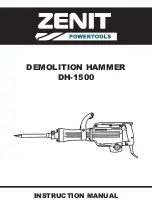
8
For technical questions call 1-800-665-8685
V 3.05
8474116
20 Gallon Pressure Abrasive Blaster
8. With the correct amount of abrasive in the tank, replace the filler cap (12).
9. Close the steel abrasive shut-off valve (18B) and open the air supply valve (18).
10. Check for air leaks at the filler cap (12) as you begin to pressurize the tank from the compressor.
WARNING! Watch the pressure gauge! Do allow the pressure in the tank to exceed 125 PSI.
OPERATION
1. Set the compressor’s regulator to 60 to 125 PSI. Do not set the compressor’s outlet regulator over
125 PSI.
NOTE:
It is good practice to keep the air compressor in a different room than the room that you will be
performing the abrasive blasting process. The fine dust created during the blasting process can damage
the air compressor. Use a longer air hose in order to reach the abrasive blaster.
2. Connect the air supply to the inlet connector (19).
CAUTION! If any leaks are detected, disconnect the air hose and make any repairs before use.
3. Open the brass air supply valve (18) to pressurize the tank.
NOTE:
The brass shut-off valve (18A) and the steel abrasive shut-off valve (18B) should be in the closed
position in order to build pressure in the tank.
WARNING! Watch the pressure gauge! Do allow the pressure in the tank to exceed 125 PSI.
4. Open the brass shut-off valve (18A) to allow air to flow through the air hose (21).
5. Open the steel abrasive shut-off valve (18B) to allow the abrasive to be moved from tank (1). This will
allow the abrasive to mix with the air from the air hose (21) and flow into the abrasive hose (24).
6. Squeeze the On/Off control lever (42) on the deadman valve to begin the abrasive blasting process.
7. When you have finished the abrasive blasting process, release the On/Off control valve (42) and close the
steel abrasive shut-off valve (18B) to stop the flow of abrasives.
8. Close the brass air supply valve (18) to stop the tank from further pressurizing and turn off
your air compressor.
9. Squeeze the On/Off control lever (42) on the deadman valve to relieve the pressure in the tank (1) and the
air line. When the pressure gauge (15) reads 0, the tank has been depressurized.
10. Close the brass shut-off valve (18A) and the brass air supply valve (18) when the tank has been
depressurized and the abrasive blasting process is complete.
OPERATING TIPS
1. The effectiveness of the blaster is increased by holding the nozzle as close to the area being
cleaned as possible.
2. Move the blaster in steady, even strokes over the area to keep the abrasive blasting surface even.
3. When the abrasive blasting process is complete, clean the blasted surface with compressed air or a soft
brush to remove any residual abrasive.
4. Refinish promptly after the blasting process is complete. Newly abrasive blasted surfaces are more
susceptible to corrosion.
TO EMPTY THE ABRASIVE TANK
1. Release the On/Off control valve on the deadman valve (42).
2. Close the steel abrasive shut-off valve (18B).
3. Close the brass air supply valve (18).
NOTE:
Turn off the air compressor (if necessary).









































